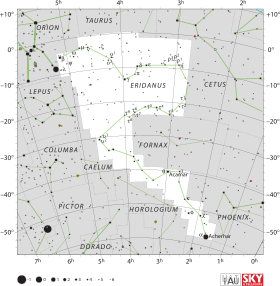Mu Eridani
| Ascension droite | 04h 45m 30,15038s[1] |
|---|---|
| Déclinaison | −03° 15′ 16,7765″[1] |
| Constellation | Éridan |
| Magnitude apparente | 4,00[2] |
Localisation dans la constellation : Éridan | |
| Type spectral | B5 IV[3] |
|---|---|
| Indice U-B | −0,60[2] |
| Indice B-V | −0,15[2] |
| Variabilité | SPB + Algol[4] |
| Vitesse radiale | 23,3 ± 4,1 km/s[5] |
|---|---|
| Mouvement propre |
μα = 15,94 ± 0,28 mas/a[1] μδ = −14,52 ± 0,16 mas/a[1] |
| Parallaxe | 6,25 ± 0,19 mas[1] |
| Distance |
520 ± 20 al (160 ± 5 pc) |
| Magnitude absolue | −2,06 ± 0,07[6] |
| Masse | 6,2 ± 0,2 M☉[6] |
|---|---|
| Rayon | 6,1 R☉[4] |
| Gravité de surface (log g) | 3,5[6] |
| Luminosité | 1 905 L☉[4] |
| Température | 15 668 K[4] |
| Métallicité | 0 [Fe/H][6] |
| Rotation | 130 ± 3 km/s[4] |
| Demi-grand axe (a) | ? UA |
|---|---|
| Excentricité (e) | 0,344 ± 0,021 |
| Période (P) | 7,380 90 j[6] |
| Argument du périastre (ω) | 160,5 ± 4,5° |
| Époque du périastre (τ) | 2 455 143,254 ± 0,067 JJ |
Désignations
Mu Eridani (μ Eri) est une étoile binaire de la constellation de l'Éridan. Elle est visible à l’œil nu avec une magnitude apparente de 4,00[2]. Avec une parallaxe annuelle de 6,25 millisecondes d'arc[1], elle est située à environ 520 années-lumière du Soleil.
En 1910, elle a été identifiée comme étant une étoile binaire spectroscopique à un spectre. Les composantes orbitent autour du centre de masse avec une période de 7,38 jours et une excentricité de 0,344, durant laquelle elles subissent des éclipses de type Algol[6]. La primaire est une étoile de type B à pulsation lente[4] de type spectral B5 IV[3]. Elle possède une vitesse de rotation relativement élevée avec une vitesse de rotation projetée de 130 km/s, ce qui correspond à moins 30 % de la vitesse d'éclatement de l'étoile[4]. L'étoile a environ six fois la masse et le rayon du Soleil, et la luminosité émise par son atmosphère externe est égale à 1 905 fois la luminosité solaire, avec une température effective de 15 668 K[6],[4].
Références[modifier | modifier le code]
- (en) F. van Leeuwen, « Validation of the new Hipparcos reduction », Astronomy & Astrophysics, vol. 474, no 2, , p. 653–664 (DOI 10.1051/0004-6361:20078357, Bibcode 2007A&A...474..653V, arXiv 0708.1752)
- (en) D. L. Crawford, J. V. Barnes et J. C. Golson, « Four-color, H-beta, and UBV photometry for bright B-type stars in the northern hemisphere », The Astronomical Journal, vol. 76, , p. 1058 (DOI 10.1086/111220, Bibcode 1971AJ.....76.1058C)
- (en) H. Levato, « Rotational velocities and spectral types for a sample of binary systems », Astronomy & Astrophysics Supplement Series, vol. 19, , p. 91–99 (Bibcode 1975A&AS...19...91L)
- (en) J. Daszyńska-Daszkiewicz, W. A. Dziembowski, M. Jerzykiewicz et G. Handler, « Oscillation modes in the rapidly rotating slowly pulsating B-type star μ Eridani », Monthly Notices of the Royal Astronomical Society, vol. 446, no 2, , p. 1438−1448 (DOI 10.1093/mnras/stu2216, Bibcode 2015MNRAS.446.1438D, arXiv 1410.6283)
- (en) G. A. Gontcharov, « Pulkovo Compilation of Radial Velocities for 35 495 Hipparcos stars in a common system », Astronomy Letters, vol. 32, no 11, , p. 759 (DOI 10.1134/S1063773706110065, Bibcode 2006AstL...32..759G, arXiv 1606.08053)
- (en) M. Jerzykiewicz, H. Lehmann, E. Niemczura, J. Molenda-Żakowicz, W. Dymitrov, M. Fagas, D. B. Guenther, M. Hartmann, M. Hrudková, K. Kamiński, A. F. J. Moffat, R. Kuschnig, G. Leto, J. M. Matthews, J. F. Rowe, S. M. Ruciński, D. Sasselov et W. W. Weiss, « μ Eridani from MOST and from the ground: an orbit, the SPB component's fundamental parameters and the SPB frequencies », Monthly Notices of the Royal Astronomical Society, vol. 432, no 2, , p. 1032−1045 (DOI 10.1093/mnras/stt522, Bibcode 2013MNRAS.432.1032J, arXiv 1303.6812)
- (en) * mu. Eri -- Eclipsing Binary sur la base de données Simbad du Centre de données astronomiques de Strasbourg.

